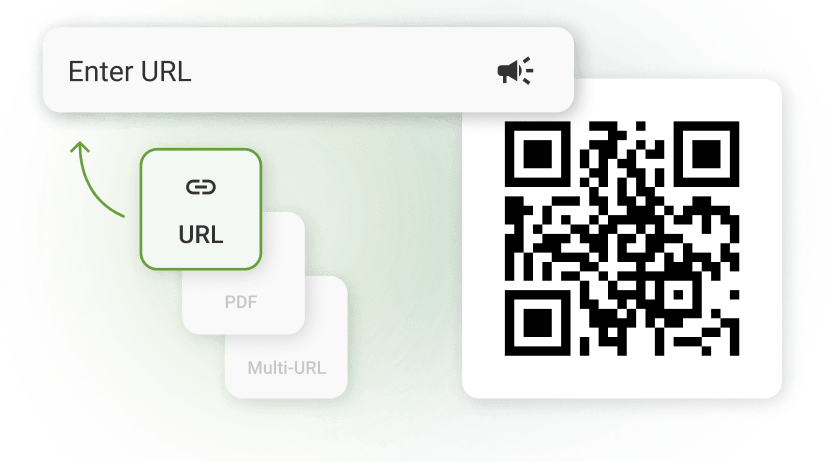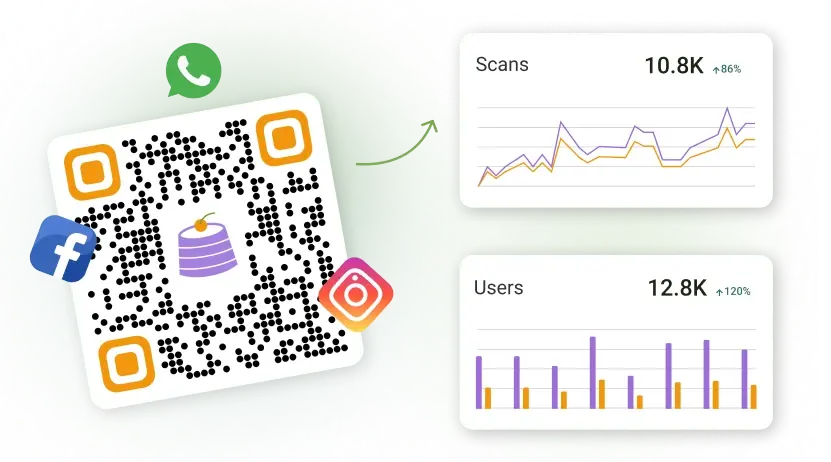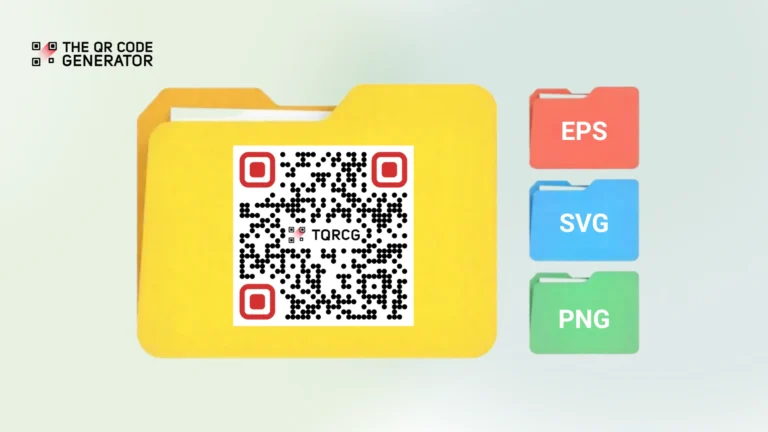Ever printed a QR Code on all your marketing collaterals, only to realize it’s not scanning? Or it turned out blurry?
You’re not alone. QR Code format matters more than you think.
Using the wrong format, like PNG on a large print ad, can lead to blurry edges, failed scans, and lost engagement. Since 94% of first impressions are design-related, a poorly formatted QR Code on print or digital campaigns can hurt your brand’s credibility and waste valuable marketing budget.
This guide covers the different types of QR Code formats and will help you choose the best for your campaign.
Table of contents
- Types of graphics for QR Codes: Raster and vector
- PNG QR Codes: Ideal for digital sharing and low-res screens
- SVG: Best for scaling without quality loss
- EPS: Go-to format for commercial printing
- 4 QR Code Formats that fall short for most use cases
- Quick comparison: Which QR Code format should you use?
- How to create a QR Code in the right format?
- 5 QR Code format mistakes (and fixes)
- How The QR Code Generator solves format headaches
- Frequently asked question
Types of graphics for QR Codes: Raster and vector
A QR Code might look simple, but its performance depends on how it’s saved and exported. The difference comes down to how the image is built: some formats are made of pixels (raster), while others are made of mathematical paths (vector).

What are raster graphics?
Raster graphics are primarily made up of pixels. When you enlarge a raster graphic, you see the square pixels. JPEG, PNG, and GIF are primary examples of raster graphics.
These are easy to edit and have quick load times, making them one of the most commonly used graphics formats online. However, they don’t do well when scaled because it can result in pixelation or blurriness.
What are vector graphics?
Vector graphics are made using mathematical equations. This means they can be scaled to any size without losing clarity or appearing blurry.
Common vector file types include SVG and EPS. Their scalability makes them perfect for both print and responsive web design.
| Feature | Raster Graphics | Vector Graphics |
| File Types | PNG, JPEG, GIF | SVG, EPS |
| Image Composition | Made of individual pixels | Made of paths defined by mathematical formulas |
| Scalability | Limited, enlarging causes pixelation | Infinite, scales cleanly at any size |
| Common Use Cases | Digital use such as websites, emails, and small screens | Print materials such as banners, packaging, and large displays |
| File Size | Smaller, quick to load | Slightly larger, but worth it for scalability |
| Editing Tools Needed | Basic editors such as Canva, Photoshop | Vector tools such as Illustrator, Figma |
While both raster and vector formats can work for small digital screens, raster is better because it loads faster at lower resolutions. But if your campaigns will be displayed on big screens or billboards, you absolutely need to go with the vector format.
QR Code size and distance from the QR Code also affect scannability. It’s important to remember the 1:10 rule while creating QR Codes. If someone needs to scan your QR Code from 10 feet away, it should be at least 1 foot wide. Only a high-resolution and scalable vector can handle that without risking errors.
Now let us look at the most common types of QR Code formats and their ideal use cases.
PNG QR Codes: Ideal for digital sharing and low-res screens
Portable Network Graphics (PNG) is one of the most popular formats for QR Codes used on digital screens. It offers crisp image quality and works seamlessly across most platforms and browsers. PNG is often the easiest and fastest option for people sharing QR Codes online.
Why PNG works well
PNG uses lossless compression, which means your QR Code remains sharp without sacrificing quality. It also supports transparent backgrounds, making it easy to blend into different designs.
Plus, PNG files are lightweight, loading quickly on web pages and not slowing down emails or landing pages.
Ideal use cases
PNG QR Codes can be used on any digital environment that doesn’t require the QR Codes to be resized significantly. The best use cases include:
- Social media platforms like Instagram, LinkedIn, or TikTok
- Email signatures and digital newsletters
- Digital ads and in-app promotions
- Business cards, brochures, and flyers where the print size is small and controlled
- PDFs or documents shared online
- Websites, to drive sign-ups or registrations. For example, UF students can access the New York Times student membership by scanning the PNG QR Code on the college’s website.

Where PNG falls short
Because PNG is a raster format, it doesn’t scale well. If you try to enlarge a PNG QR Code for a poster, banner, or booth display, it can appear pixelated and blurry. This can lead to scan failures and a poor brand impression.
Moreover, unlike SVG or EPS formats, PNG isn’t easy to customize to suit your brand guidelines. Changing colours or shape may affect the quality of the QR Code.
SVG: Best for scaling without quality loss

Scalable Vector Graphics (SVG) is a modern, web-friendly format that’s flexible, easy to scale for big screens, and doesn’t pixelate.
But what truly sets SVG apart is its flexibility. It’s a developer and designer-friendly format that can be directly embedded into websites. You can animate or style SVG QR Codes via XML or import them into tools such as Figma and Illustrator for advanced editing.
Pro Tip: Always print your QR Code on 2D surfaces Even with the perfect SVG format, surface matters. If a QR Code is printed on curved, textured, or uneven materials, it can warp the design and make it unscannable. For the best results, use flat, high-contrast surfaces to ensure reliable scans. |
Why SVG stands out
SVGs can be implemented into brand designs, support transparency, and are easy to customize. They load up to 60-80% faster than PNGs, making them great for performance-conscious websites. Moreover, because SVGs are resolution-independent, they deliver consistent scan quality across every screen size and print format.
SVG also works great for print when the size is moderate and you’re using modern design tools such as Figma, Illustrator, or Inkscape.
Ideal use cases
SVGs can be used for interactive, large-scale campaigns such as:
- Responsive websites and landing pages
- Billboards, banners, and signs. For example, the OR Foundation used a QR Code on its digital billboard to warn consumers about the impact of fast fashion.
- Interactive kiosks and digital signage
- Product packaging with integrated scannable experiences
- Editable brand assets that require resizing (e.g., logos with QR Codes)
- Event marketing, customer surveys, or educational posters
- Mobile payment flows and contactless menus
Where SVG may fall short
SVG isn’t without its quirks. While rare today, older browsers like Internet Explorer 11 may struggle to render SVGs correctly. Also, SVG primarily uses RGB, which is ideal for screens but not always the best if you use legacy software such as Adobe InDesign or CorelDRAW for print design.
EPS: Go-to format for commercial printing
EPS (Encapsulated PostScript) is a professional-grade vector format specifically designed for print production. It supports Cyan, Magenta, Yellow, and Key (CMYK) color profiles. It is ideal for complex or large-scale materials where quality can’t be compromised.
Why EPS works well
Graphic designers and printers typically use EPS in tools such as Adobe Illustrator or CorelDRAW. It is best reserved for projects headed to commercial printers. EPS ensures that your print quality is perfect even at 300 dots per inch (DPI) or higher.
Ideal use cases
Non-interactive print campaigns are ideal for EPS, but they’re not a good option for print campaigns. Some of the most common use cases are:
- Billboards and building wraps. For example, TIME magazine added a QR Code in the EPS format for their billboard at Time’s Square New York.
- Vinyl banners, storefront signage, and trade show displays
- Product packaging with high-resolution requirements
- Magazines, brochures, and catalogs
- Branded apparel and wearables
- Any large-scale advertising where print quality can’t be compromised
Where EPS falls short
While EPS is great for printing, it’s not the best for digital displays. It requires specialized design software to open or edit, making it less practical for casual users.
They also usually have larger file sizes, which can slow down uploads and processing. Formats like SVG offer more flexibility and accessibility for applications beyond commercial printing.
While the most essential and valuable QR Code formats have been covered so far, there are a few others that businesses or professionals may opt for. They aren’t the best for commercial campaigns, but might fit a few specific use cases. Let’s take a look at them.
4 QR Code Formats that fall short for most use cases
Not all image formats are suitable for QR Code usage. Some have serious limitations regarding scan accuracy, file size, and design compatibility. Here’s where common alternatives fall short.
JPEG/JPG
JPEGs are everywhere online, but they are a poor fit for QR Codes. They use lossy compression, which permanently removes image data to reduce file size. This can blur the precise edges of a QR Code, leading to inaccurate scanning. Additionally, they do not support transparency, which can limit customizability.
PDFs are interesting, as they can be either vector or raster graphic type. However, they are not very designer-friendly if you need to make minor changes. Furthermore, their file size is heavier. It’s best to use other formats in place of PDF for QR Codes.
However, they are great to use when the QR Code is part of a larger document, such as a brochure, proposal, or client assets, where further instructions need to be added.
TIFF and BMP
TIFF and BMP are raster graphics that prioritize quality but are uncompressed. But they are currently a little outdated for QR Code usage. Their file size can result in slower uploads and load times.
Furthermore, BMP files don’t support CMYK, which can be a hurdle for prints. They essentially offer no real advantage over other modern file formats.
GIF
GIF might seem like a creative option, but it’s a poor format for functional QR Codes. It supports only 256 colors, which increases the risk of contrast issues and color banding. It can also disrupt a scanner’s ability to read the code. Plus, it often interferes with its structure. So while it looks cool, GIF QR Codes do more harm than good.
Now that all the QR Code formats have been covered, here’s a quick comparison table to help you confidently choose the one that best fits your project.
Quick comparison: Which QR Code format should you use?
| Format | Scalability | Digital Use | Print Use | Relative File Size | Main Limitation for QR Codes |
| PNG | Limited (pixelates when scaled up) | Excellent (web, email, social media) | Small scale (business cards, flyers) | Moderate/Lightweight | Blurs/pixelates on enlargement |
| SVG | Infinite | Excellent (web, digital screens) | Any scale (banners, posters) | Very Small (XML-based) | Complex editing for non-designers |
| EPS | Infinite | Limited (not web-friendly) | Large-scale pro print (billboards) | Large | Rarely supported on the web, editing may lose features |
| JPG | Limited (pixelates when scaled up) | Acceptable (PNG preferred) | Only when small file/low quality needed | Very Small | Quality loss, poor for sharp lines |
| Varies (vector info preserved if present) | Document sharing (not direct image use) | Document sharing or embedding | Can be large for documents | Not ideal as a direct QR code image; content may not be mobile-friendly |
After you choose the correct QR Code format, you can easily create a trackable one for all your campaigns, print or digital, with The QR Code Generator.
How to create a QR Code in the right format?
Here’s how you can create and download your QR Code in the format that best suits your needs using The QR Code Generator (TQRCG).
Step 1: Creating your QR Code

Select the type of QR Code based on your use case. Add the link or the details you want your QR Code to display. When you are happy with it, click on Next.
Step 2: Customize your QR Code

Change your QR Code’s color, add your logo and modify its shape to your liking. You can use your brand’s guidelines to make it cohesive with your brand identity. Click on Save to download your QR Code.

The QR Code Generator (TQRCG) offers two formats for QR Codes. Download in PNG if you are using it digitally. You can also adjust the image size to prevent blurring. If you will use your QR Code in printing material, go for the SVG format. Name your QR Code and click Download.
Now that your QR Code is ready, there are minor tweaks you can make to it before it goes live.
5 QR Code format mistakes (and fixes)
Even with the right intent, small formatting errors can make your QR Codes unscannable. This can lead to lost leads, failed campaigns, or a poor user experience. Here are the most common QR Code format mistakes and how to avoid them.
Mistake 1: Using PNG for large-format prints
While PNG is great for digital use, it breaks down when scaled up for posters, banners, or signage.
The fix: Switch to SVG for print as it can ensure sharpness at any size without pixelation.
Mistake 2: Exporting SVG as a raster image
Exporting your SVG from a vector tool but saving it as a PNG or JPG defeats the purpose. Your QR Code can end up blurry and cost you money.
The fix: Always save your file in true .svg format to retain full scalability and interactivity.
Mistake 3: Ignoring DPI settings
Low-resolution QR Codes (e.g., 72 DPI) may look fine on screen but fail badly while printing.
The fix: Higher DPI means higher resolution. Follow the industry standard and use 300 DPI for print materials and 72 DPI for web and email assets.
Mistake 4: Overcomplicating QR Code designs
Excessive colors, gradients, or patterns may look stylish but often disrupt scan reliability.
The fix: Keep it simple and stick to high-contrast, clean designs. But that doesn’t mean giving up on creativity. Use your brand color and tweak its designs. For best results, use a reliable QR Code generator.
Mistake 5: Skipping real-world scan tests
Just creating and printing your QR Code without testing can prove to be a costly affair. Your printing materials can become useless if the ultimate CTA doesn’t work.
The fix: Always test before you publish. Test your QR Code in various environments and using multiple devices. If it’s going to be displayed on a moving vehicle or outside, test it in different lighting and contrasts as well.
How The QR Code Generator solves format headaches
At the end of the day, the format you choose for your QR Code directly affects how well it works in the real world. A crisp PNG might be perfect for your email footer, but try scaling it up for a poster, and it’s a no-go. On the flip side, an EPS or SVG might be overkill for something small and digital.
That’s where The QR Code Generator (TQRCG) makes life easier. It gives you quick access to multiple formats, so you’re never stuck with the wrong one. You can update your QR Code’s content without reprinting, switch formats , and even track where your scans are coming from.
So whether you’re launching a social campaign or printing thousands of flyers, TQRCG can help you get it right the first time. Try it out now!
Sign up to create a free QR Code!
Frequently asked question
SVG format is the best choice for business card QR Codes. SVG ensures your QR code remains crisp, clear, and free from pixelation. It is perfect for maintaining high-quality visuals on print materials.
You can safely convert vector QR Code formats (such as SVG or EPS) to raster formats like PNG without losing quality. However, converting from raster formats (PNG, JPG) back to vector formats may result in a loss of clarity. For guaranteed quality, always retain a master QR Code in vector format whenever possible.
For print, ensure your SVG QR Codes are at least 300 DPI (dots per inch). For a QR Code measuring 1 inch x 1 inch, this means a minimum image size of 300×300 pixels. High-resolution QR Codes are essential for reliable scanning and crisp print quality.
No, QR Code format support depends on the generator. Some tools offer only PNG, while others provide vector options such as SVG or EPS.
SVG format typically loads fastest on websites, especially when optimized for web use. PNG can also be fast but may require more processing power for complex designs.
Always test your QR Codes across various devices and scanning environments to ensure compatibility and reliability. Monitor your scan success rates and gather user feedback to confirm that it works.







